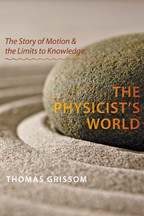How do students learn about physics without picking up a 1,000-page textbook chock-full of complicated equations? The Physicist’s World is the answer. Here, Thomas Grissom explains clearly and succinctly what physics really is: the science of understanding how everything in the universe moves.
From the earliest efforts by Presocratic philosophers contemplating motion to the principal developments of physics through the end of the twentieth century, Grissom tells the unfolding story of our attempt to quantify the material world and to conceptualize the nature of physical laws.
Through the...
How do students learn about physics without picking up a 1,000-page textbook chock-full of complicated equations? The Physicist’s World is the answer. Here, Thomas Grissom explains clearly and succinctly what physics really is: the science of understanding how everything in the universe moves.
From the earliest efforts by Presocratic philosophers contemplating motion to the principal developments of physics through the end of the twentieth century, Grissom tells the unfolding story of our attempt to quantify the material world and to conceptualize the nature of physical laws.
Through the centuries, questions about why things move proved to be unanswerable in any absolute, satisfying way. Instead the question became how things move, a direction of thought that led to the rise of modern science. Physics emerged as a mathematical description of the motion of matter and energy, a description believed to be complete and exact, limited only by the precision of measurement. Grissom shows that in one of the great intellectual ironies, advancements in twentieth-century physics affirmed instead that this quantitative theory was capable of discovering its own limits. There is only so much that physics can reveal about the world.
This is physics for the thinking person, especially students who enjoy learning concepts, histories, and interpretations without becoming mired in complex mathematical detail. A concise survey of the field of physics, Grissom’s book offers students and professionals alike a unique perspective on what physicists do, how physics is done, and how physicists view the world.






